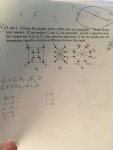Hello Math forums,
I know the rules are to ask a specific question here, but I am afraid I am not able to make it quite far on this problem as the teacher barely covered it on our last day of class.

I understand an Isomorphic graph is when two graphs have similar properties in a way that some function can create a bijection to preserve adjacency,
Problem is i can't quite figure out how to do this,
the # of vertices are = and the deg sequence of all 3 graphs are the same.
No idea how to prove anything else though.
Would anyone mind taking the time to help me out?
Thanks
I know the rules are to ask a specific question here, but I am afraid I am not able to make it quite far on this problem as the teacher barely covered it on our last day of class.

I understand an Isomorphic graph is when two graphs have similar properties in a way that some function can create a bijection to preserve adjacency,
Problem is i can't quite figure out how to do this,
the # of vertices are = and the deg sequence of all 3 graphs are the same.
No idea how to prove anything else though.
Would anyone mind taking the time to help me out?
Thanks
Last edited by a moderator:
